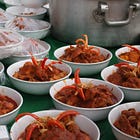Indievore is an exploration of my Eurasian culinary heritage which is a story of ingredients, methodologies and taste that journeyed between Asia and Europe including the Americas and Africa reflecting the path of trade, colonisation and the movement of people and their ideas across these regions.
ABOUT EURASIAN FOOD
Eurasian Food is a unique hybrid cuisine that broadly reflects the culinary dialogue between men from a variety of European backgrounds: Portuguese, Dutch, German, French, English and more, at the table eating food from a kitchen prepared by a native wife or cook also from a variety of Asian backgrounds: Indian, South East Asian, Chinese perhaps even a freed slave from Mozambique.
In the background is the vibrant era of the East Indies spice trade and the influence of new technologies, tastes, geography, ethnicity and the cultural ideas they bring. Entirely new ingredients like chillies and potatoes would redefine Asian cuisine and food technologies like baking that required ovens, wheat and dairy would spur the adoption of new devices and innovative substitutions - like substituting coconut milk for dairy, rice flour for wheat flour, palm vinegar for wine vinegar.
Over time variations would emerge within the Eurasian community reflecting the tastes and backgrounds of Anglo Indians and Sri Lankan Burghers settled in Singapore, Portuguese Malay Eurasians in Malacca and Christianised Thai Eurasians in Penang with many of the nuances of these variations lost over time. Some things like Pineapple tarts would become so popularised in the broader population that their origin stories from ingredients brought by the Portuguese or European methods like baking and jam making disappear in modern day retelling.
The aim here is to rediscover the rich histories of dishes not only on Eurasian tables but also many that are now also familiar on Malaysian tables attributable to the complex fabric of influence, exchange and hybridity that began in a Eurasian kitchen. There is also in this endeavour potential for new culinary ideas that may have begun in the 16th century but have modern relevance for a similarly globalised world that is hyper connected and curious for new ideas.














